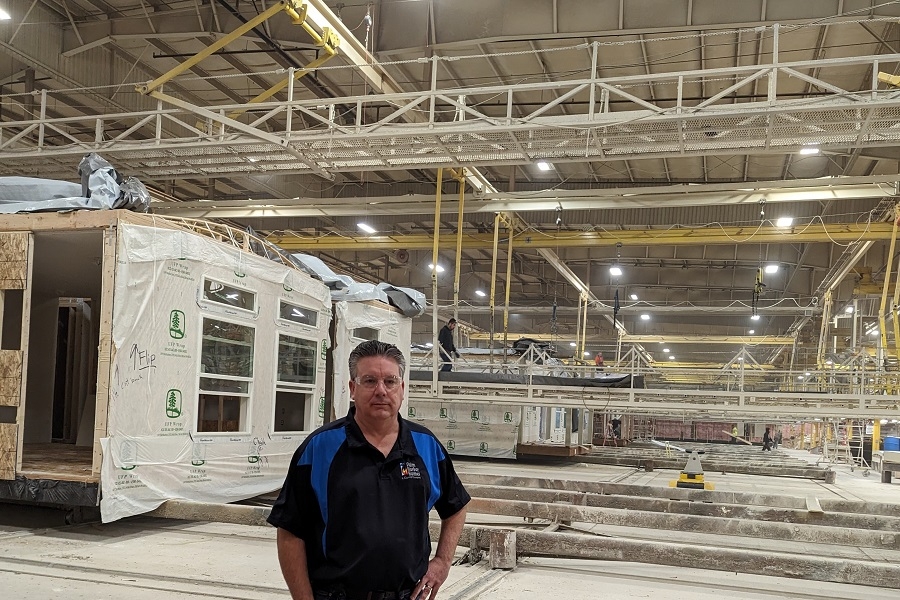Manufactured housing could meet up to 10% of Oregon’s housing needs, industry insiders say.
Ben Roche, sales director for Palm Harbor Homes in Millersburg, says he appreciated that Gov. Tina Kotek toured the Port of Portland’s Terminal 2 in January to assess the speed and effectiveness of Hacienda’s Mass Casitas modular housing pilot. He says the project was a good way of bringing attention to prefabricated homes, which have a significant part to play in solving Oregon’s housing shortage, but expressed concern that existing manufactured housing builders in Oregon have been overlooked by the state’s plan to increase Oregon’s housing supply.
“While I can appreciate the governor’s sentiment and bringing awareness to those companies, I find it odd that when one out of 10 new homes built are manufactured homes, her Housing Council completely ignored a segment of housing that’s existed in Oregon for decades,” Roche says.
Roche says three members of the Oregon Manufactured Housing Association, an industry group representing Oregon’s five manufactured housing companies, applied to be part of the governor’s Housing Production Advisory Council, which began accepting applications for membership in February. But none were selected, he says.
RELATED STORY: Governor Kotek Celebrates Speed of Mass Timber Modular Housing Pilot Project
Both modular and manufactured homes are built in factories as opposed to onsite, a process that increases speed and cost-effectiveness. The difference between the two types is that modular homes are held to the same local, state and regional building codes required for onsite homes, while manufactured homes are built to the national HUD code. This means modular homes required more skilled plumbing and electrical labor to produce, rather than owners having to comply with state housing standards after the fact.
Another distinguishing factor is the foundation. Manufactured homes with a pier and beam foundation can typically be relocated by a contractor. Manufactured homes can also be placed on a permanent foundation, crawl space, or basement. Manufactured homes can be outfitted with state-specific requirements, and Roche says many of his homes are currently in Oregon, as well as Washington, California, Idaho, Alaska, and Montana.
Oregon already has five manufactured housing shops in operation. Roche says that when it comes to meeting the governor’s ambitious housing goal of producing 36,000 new homes annually.
RELATED STORY: Industry Veteran: Oregon Poised to Become a World Leader in Manufactured Homes
“Whether it’s modular or manufactured, most production builders have an assembly line with an infrastructure. They have tooling on site CNC machines, a cabinet shop on site, you know, framing and fixtures for framing squarely walls and tables,” Roche says. “We have the ability to scale up. It’s much easier to take our facilities that build 600 homes a year and turn that into 700 or 800 homes a year than it is for a startup that’s building 10 homes a year and get them to get to 20.”
A 2022 industry review by the Manufactured Housing Institute found production of manufactured homes is on the rise across the country. In 2021, 105,775 manufactured homes were built in the United States, compared with 94,401 homes in 2020, a net increase of 12%. Roche says his industry also saw a spike in demand during COVID-19 and the Labor Day fires. The resulting increase in production is one of the reasons his industry hasn’t been as involved in the state’s housing discussion, as it left him and his colleagues with little time for outreach.
Some companies across the United States have already tried to pilot modular housing factories using mass timber. But they haven’t necessarily succeeded: Silicon Valley startup Katerra, which failed after more than $2 billion of investment.
Jody Lyon, executive director of the Oregon Manufactured Housing Association, says manufactured homes like the ones built at Palm Harbor Homes can be delivered to a property six to eight weeks after the product is ordered, and move-in ready in approximately six months.
She told Oregon Business manufactured housing factories have the capacity to scale up to meet demand, take a sizeable bite out of the state’s housing crisis, and make good use of the state’s growing laminated and mass timber market.
“Historically, these last few years as an industry have been able to build around 2,000 to 3,000 homes a year, and we could increase that substantially. With 36,000 homes a year as a goal, we could potentially fill about 10% of that with our industry. That’s the message we’re trying to get across to Gov. Kotek, Rep. [Pam] Marsh and different legislators. We are a significant part of this solution,” says Lyon.
Roche described Ashland Democrat Pam Marsh as a champion for manufactured housing. He said Marsh has been “instrumental” in Hope Community Corporation getting $15 million of startup capital for a manufactured housing factory in Eugene as a resource for wildfire survivors.
“I originally thought she was interested in helping make manufactured homes more affordable and get the capacity up, as more supply will result in lower pricing and wait times for people in need of housing,” says Roche.
Roche says regulatory barriers stand in the way of manufactured housing being able to compete with modular housing for financing. According to the Oregon Department of Revenue, manufactured homes are considered personal property, and have a title like a car or RV called a manufacturers’ certificate of origin. They are owned separate from the land they sit on. If modular homes, by contrast, are placed on a property, Roche says the home would be “practically impossible” for the owner to separate it from the park. This ability to separate assets makes financing manufactured parks less financially appealing than modular homes for a site developer.
According to Roche, in 2022, Marsh and Roche had some conversations where she showed interest in developing private land with manufactured homes — but then she ceased communication. Now he fears manufactured housing could miss another opportunity with $200 million in housing assistance from House Bill 2001 and House Bill 5019, which passed the house on Wednesday with bipartisan support.
“I think the direction she is going [for HB 2001] is to fund modular apartments built by Intelifab in Klamath Falls, and Portland developer Tom Cody is one of the people selected to Tina Kotek’s Council for housing production,” says Roche.
Marsh tells OB that she does not recall the specific project she spoke with Roche about, but also says manufactured homes are and will continue to be part of Oregon’s housing strategy. She says modular homes are more appealing to some developers, and while Oregon already has manufactured housing producers, the state’s modular housing industry still needs to grow.
“The takeaway here is that we aren’t prioritizing one housing type or another. We have great manufactured housing companies in Oregon already, but in terms of modular factories we have zero. We’re looking at which industry needs the boost,” says Marsh. “I have a developer in my district who wants to build [stackable] modular units but there’s no factory or builder around to accommodate the order.”
She says there is already support for manufactured housing on her legislative agenda. The first is HB 2983, which would allocate $55 million funding for the preservation and development of new manufactured home parks. The second bill, HB 3151, limits improvements that landlord of manufactured dwelling park may require of tenant – and is scheduled for a floor reading Tuesday.
Roche says his industry is looking for recognition that homeowners need some help with down payments on housing, and that using Oregon’s existing manufactured housing infrastructure will be a better bet on Oregon’s housing future than trying to create companies and factories from scratch.
“I sat on the housing council meeting [March 10], and I will say there are some stakeholders in there. They did talk about the needs for buildable land, expansion of the urban growth boundaries, so I’m not going to say that we are being totally ignored. But when we’re looking at spending $120 million more in one omnibus bill like HB 2001, I think you could get a much larger bang for your buck if you put that money directly in the hands of consumers and ways of developing land to be built on than actually trying to produce a factory that doesn’t exist yet,” says Roche, who adds that while manufactured housing can’t be a silver bullet to solve Oregon’s housing crisis, it can and should be more of a solution than it is currently.
“We’re trying to reach out to the policymakers and say, ‘Don’t forget about us.’ We’re still over here producing homes,” Roche says. “We’ve just been a little bit too busy to engage because we had a huge demand for homes in the last three years, but we’re ready to be part of the solution.”
To subscribe to Oregon Business, click here.









